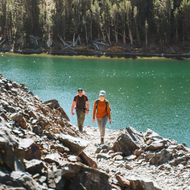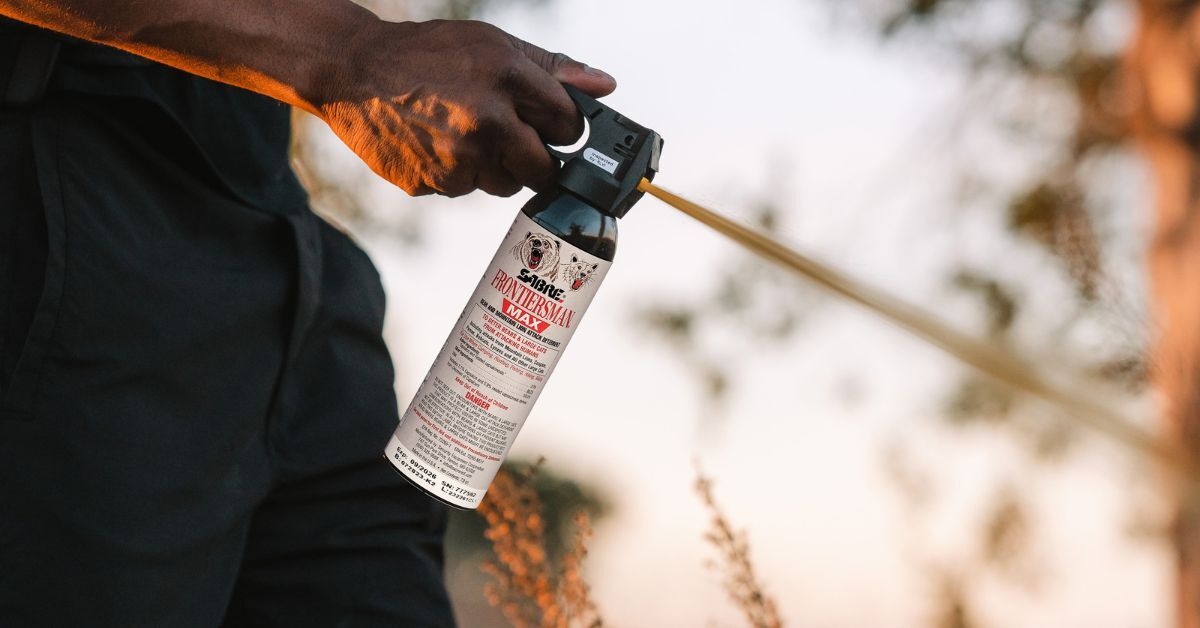Bear Safety: What To Do If You Encounter A Bear?
06 24 2025
Bear season is in full swing. As temperatures rise, bears across North America are no longer in hibernation and they are ready to enjoy the warm weather of the spring and summer months. That means hikers, campers, and outdoor explorers need to start thinking about bear safety again. If you’re planning a short day hike or a multi-day backcountry camping trip, knowing what to do during a bear encounter could save your life. From essential gear to defensive strategies, here’s how to protect yourself and others from a bear attack on the trail.

Unsplash: Holly Mandarich
How to be Prepared for a Bear Encounter
Conducting research before your adventure will be your greatest tool on the trail. Not all trails and parks are the same. While the scenery may be stunning, the types of wildlife you could encounter can vary by different regions. Some parks are home to black bears, others to grizzly bears, and some, like parts of Montana, Wyoming, and Alaska, may even have both. You may even encounter mountain lions, as they are active in the spring, summer, and fall. Not all bears will behave the same way in an encounter, and knowing the difference could save your life.
Before you hit the trail:
- Research the park’s official website:Look for up-to-date information on trail conditions, wildlife, and any recent bear sightings. Many parks will post real-time advisories to let visitors know which areas to avoid.
- Stop by the ranger station:When you arrive at your trail, check in with a park ranger. They often have the most current information about bear activity, trail closures, or unusual behavior that hasn’t yet been posted online.
- Learn how to identify different types of bears:Color isn’t always a reliable indicator when differentiating black bears and grizzly bears. Learn about their characteristics and behaviors to help you spot the difference between a black bear and a grizzly bear. Know how to respond to different types of bears during an encounter.
- Be prepared:Being well-equipped with bear spray and other accessories will help deter a bear during an encounter. It is always best to be too prepared when it comes to bear country.
Explore the Best Bear Defense Options
When it comes to protecting yourself in bear country, your gear matters just as much as your knowledge. Bear spray remains one of the most effective tools for deterring an aggressive bear, and many parks will recommend carrying it as a precaution. Always research ahead of time to ensure that bear spray is permitted at your destination.
Most importantly, don’t bury your bear spray in your backpack; keep it within quick reach. A chest or belt holster is a great option to stay hands-free while still having quick access to your bear spray. Unsure of what to look for when shopping for bear spray? Look for EPA-registered sprays with strong formulas, long spray distances, and wide dispersion patterns. Recently recognized as the ‘Best of the Best’ by the Chicago Tribune, the SABRE Frontiersman MAX Bear Spray offers 2.0% major capsaicinoids concentration, a 40-foot range, and controlled burst deployment, providing top-tier protection against both bears and mountain lions.
Additional accessories like bear bells, air horns, and bear-resistant food containers can also play a key role in preventing encounters in the first place. A layered approach to bear safety gives you the best odds of staying safe.
What to Do During a Bear Encounter
If you come face to face with a bear, your reaction could determine the outcome. The best tip is to stay calm and never run. Running may trigger an attack or chase response, and bears can easily outrun humans, especially on rugged terrain.
- Identify the type of bear:If it’s a black bear, you may be able to scare it off by standing tall, speaking firmly, and making yourself appear larger. If it’s a grizzly, avoid eye contact and speak in a calm voice while slowly backing away.
- Don’t turn your back:Continue facing the bear while slowly increasing the distance between you and the animal. You do not want to appear as prey, so make yourself look big!
- Use your bear spray:If the bear approaches within 20-40 feet and appears aggressive or charges, deploy your spray while aiming slightly downward to create a barrier of deterrent between you and the bear.
How to Avoid a Bear Encounter
Prevention is the best protection when exploring bear country. Here are a few tips to avoid a bear encounter:
Know the Different Types of Bears
Understanding the wildlife you may encounter is a crucial first step in staying safe. Both black bears and grizzly bears can vary greatly in color and size, which can make quick identification challenging. In a real encounter, you might only have a few seconds to assess the situation. One of the most reliable ways to distinguish them is by looking for a shoulder hump—grizzlies have a prominent one, while black bears do not. That’s why it’s important to focus on physical features beyond color, such as overall size, shoulder structure, face shape, ear placement, and claw length. Once the bear is identified, you can decide which actions to take.
Explore Other Bear Deterrents
Whenever possible, hike in groups as there is safety in numbers. Groups are more likely to deter wildlife as they tend to be louder. Make an effort to create consistent noise as you move: talk loudly, clap, or call out. This is especially important when approaching bends, dense brush, or noisy streams. Surprising a bear is the last thing you want.
Bear bells can be a useful addition to your gear, providing a steady sound to signal your presence. For extra caution in low-visibility areas, consider carrying an air horn to give a louder warning every ¼ of a mile. However, keep in mind that noise-making tools are meant for prevention only. They do not replace bear deterrents like bear spray, which should always be carried and easily accessible.
Secure Your Food
Whether you're camping or eating a snack on a trail, never leave food, trash, or scented items unattended. Remember to always take your trash with you when you’re on a trail. Not only will it prevent bears, but littering is bad for the environment! At your campsite, we recommend using bear-proof food containers and always following park regulations when it comes to food storage. At night, store food away from your tent, either in a bear locker or hung properly from a tree.
Enjoying the outdoors means sharing the space with wildlife and respecting their home. While bear encounters are rare, preparation is key to making sure your next adventure is both memorable and safe. Know the risks, carry the right gear, and take the time to educate yourself before you go.
Because it’s always better to be cautious than caught off guard.



